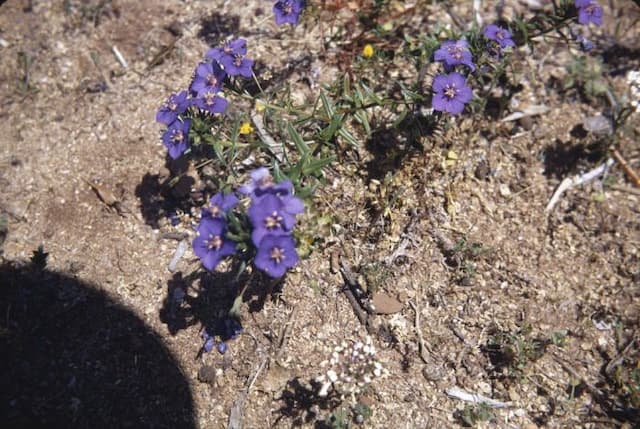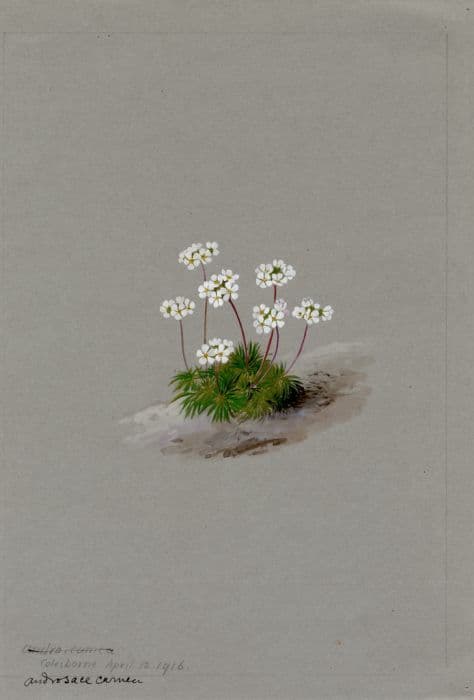Orchid Primrose Primula vialii 'Alison Holland' (So)

ABOUT
Primula vialii 'Alison Holland' is an eye-catching perennial that presents itself with a combination of unique and appealing features. The plant is distinguished by its striking flower spikes which bear a resemblance to elongated, pointed rockets about to launch. At the base of the spike, the flowers are enclosed in a whirl of green bracts that transition into a soft purple-pink shade as the tightly packed buds ascend. As the bloom season progresses, the top tiers of the flower spike open to reveal individual flowers that spread out as delicate star shapes in a brilliant white hue. These contrasting colors create a vivid display that stands out in any garden setting. The foliage of this plant is also noteworthy – the leaves form a rosette at the base, lush and green, with an inviting, textured appearance. They are shaped oval to lance-like with arranged margins giving a sense of fullness to the plant's basal area. Overall, Primula vialii 'Alison Holland' offers a dramatic visual appeal with its distinctive flower spikes that taper towards the top, coupled with the lush foliage, all contributing to a plant that is aesthetically pleasing and often sought after for ornamental purposes.
About this plant
 Names
NamesFamily
Primulaceae.
Synonyms
Orchid Primrose, Vial's Primrose, Red-Hot Poker Primrose.
Common names
Primula vialii 'Alison Holland'.
 Toxicity
ToxicityTo humans
The plant known as Primula vialii, or commonly as orchid primrose, is not considered highly toxic to humans. There is limited information on its toxicity, but as with many plants, it is generally recommended not to ingest any part of it as it may cause stomach upset or an allergic reaction in some individuals. If you suspect ingestion and have concerns about poisoning, it is best to consult a medical professional.
To pets
The orchid primrose is also not known to be highly toxic to pets. However, pets may have a sensitivity to plants that humans do not, so it's recommended to prevent your pets from ingesting the plant. If a pet does consume part of the orchid primrose, they may experience mild gastrointestinal upset, like vomiting or diarrhea. If you observe any adverse reactions in your pet after ingestion, contact your veterinarian.
 Characteristics
CharacteristicsLife cycle
Perennials
Foliage type
Deciduous
Color of leaves
Green
Flower color
Mixed
Height
1-2 feet (30-60 cm)
Spread
1 foot (30 cm)
Plant type
Herb
Hardiness zones
5
Native area
China
Benefits
 General Benefits
General Benefits- Ornamental Value: 'Alison Holland' adds aesthetic appeal to gardens with its unique floral spikes that feature a gradient of color from red at the top to white at the base.
- Attracts Pollinators: The vibrant colors and nectar-rich blooms attract bees, butterflies, and other pollinators, enhancing biodiversity in the garden.
- Low Maintenance: Once established, it requires minimal care, making it suitable for gardeners with limited time.
- Hardy Plant: It is tolerant of cold temperatures, which allows it to thrive in cooler climates and resist late spring frosts.
- Good for Borders: With its compact size, 'Alison Holland' is excellent for creating borders or adding structure to mixed perennial beds.
- Long Blooming: It has a lengthy blooming period, providing color and interest in the garden for an extended time during the growing season.
 Medical Properties
Medical PropertiesThis plant is not used for medical purposes.
 Air-purifying Qualities
Air-purifying QualitiesThis plant is not specifically known for air purifying qualities.
 Other Uses
Other Uses- Primula vialii 'Alison Holland', commonly known as orchid primrose, can be utilized as a natural dye for fabrics, offering a range of muted green and yellow hues depending on the mordant used.
- In creative arts, the orchid primrose's unique flower spikes can be used to make botanical prints, where the pigments and shapes of the flowers are transferred to paper or fabric to create natural designs.
- Its vibrant blooms are sometimes used in the crafting of eco-friendly confetti, which can decompose naturally, reducing environmental impact.
- Orchid primrose petals can be infused into oils to create naturally scented candles with a delicate, floral aroma.
- These plants can serve as educational tools in biology classes, illustrating the parts of a flower and pollination processes with their distinct structure.
- Orchid primrose can be used in the culinary world as an ornamental edible to garnish desserts and salads, though consumption should be done with caution and knowledge about the plant's edibility.
- Their tall stalks and vibrant colors make orchid primrose useful for floral arranging and creating naturalistic garden-inspired bouquets.
- They can be employed in photography, specifically in macro photography, where the intricate details of the orchid primrose flowers can be highlighted.
- On a larger scale, orchid primrose can contribute to landscape design, providing a pop of color when planted en masse in meadows or grassy banks.
- Crafters may use the dried seed pods and flowers of the orchid primrose in the creation of potpourri, lending a unique texture and form to the mix.
Interesting Facts
 Feng Shui
Feng ShuiThe Orchid Primula is not used in Feng Shui practice.
 Zodiac Sign Compitability
Zodiac Sign CompitabilityThe Orchid Primula is not used in astrology practice.
 Plant Symbolism
Plant Symbolism- Originality: The unique form and distinct appearance of Primula vialii 'Alison Holland', also known as the Vial's primrose, symbolize originality and standing out in a crowd.
- Renewal: As a spring-blooming flower, the Vial's primrose represents renewal, new beginnings, and the rejuvenation of nature after winter.
- Youthful Joy: With its bright and cheerful colors, the Vial's primrose is often associated with the playfulness and joy found in youth.
- Hope & Optimism: The Vial's primrose, emerging as one of the early flowers in spring, carries the message of hope and optimism for the upcoming season.
 Water
WaterThe Orchid Primrose should be watered thoroughly, allowing the soil to become moist but not soggy, typically one to two times per week depending on climate conditions. During the growing season (spring and summer), it may require up to 1 gallon of water per week for outdoor plants, with indoor potted plants needing slightly less. During winter, the watering frequency should be reduced to when the soil surface feels dry to touch. It's crucial to avoid waterlogging, as this can lead to root rot in the plant.
 Light
LightThe Orchid Primrose thrives best in partial shade to filtered sunlight. It can tolerate full morning sun, but should be protected from harsh afternoon sunlight to prevent leaf burn. A spot that receives dappled sunlight throughout the day or a position under the light shade of a tree would be ideal for this plant.
 Temperature
TemperatureThe Orchid Primrose is comfortable in temperatures ranging from 50 to 70 degrees Fahrenheit. They can survive a minimum temperature of about 40 degrees Fahrenheit, but to maintain healthy growth, keeping them within the ideal range is recommended. This plant does not tolerate extreme heat or cold well.
 Pruning
PruningPruning the Orchid Primrose is mainly done to remove spent flowers and dead foliage to encourage a tidy appearance and promote new growth. The best time for pruning is immediately after flowering has ended. It's typically necessary to prune these plants once a year, as they are not fast-growing.
 Cleaning
CleaningAs needed
 Soil
SoilOrchid Primula prefers moist but well-draining soil, rich in organic matter with a neutral to slightly acidic pH of around 6.0 to 7.0. A good mix can be made of peat, loam, and coarse sand or perlite in equal parts to ensure proper drainage and aeration.
 Repotting
RepottingOrchid Primula generally needs repotting every 1-2 years or when it becomes root-bound. Best time to repot is after flowering, in late spring or early summer.
 Humidity & Misting
Humidity & MistingOrchid Primula thrives in high humidity conditions, ideally between 75-85%. Avoid placing it in excessively dry environments to maintain its vitality.
 Suitable locations
Suitable locationsIndoor
Use bright indirect light, high humidity, and cool temps.
Outdoor
Plant in partial shade, moist soil, protect from hot sun.
Hardiness zone
5-7 USDA
 Life cycle
Life cyclePrimula vialii 'Alison Holland', commonly known as orchid primrose, begins life as a seed which, once sown in moist, well-drained soil, germinates within a few weeks under right temperature conditions. The seedlings develop into a rosette of leaves, gradually forming a deep taproot, with the plant focusing on vegetative growth in its initial stages. During the spring or early summer of the following year, it enters the flowering stage, showcasing distinctive tiered spikes of lilac-pink to red buds opening to delicate white flowers. After pollination, typically by insects, these flowers develop into small capsules containing numerous tiny seeds, completing its reproductive cycle. During the late summer or fall, the plant begins to die back, entering a dormant stage through the winter. With the return of favorable conditions in spring, the plant emerges from dormancy to start the growth and reproductive cycle anew.
 Propogation
PropogationPropogation time
Spring-Early Summer
Primula vialii 'Alison Holland', also known as 'Alison Holland' Primrose, is best propagated by division, a method usually done in the early fall or immediately after the plant has finished flowering in late spring or early summer. To propagate by division, carefully lift the plant out of the soil with a garden fork, aiming to minimize root disturbance. Once lifted, gently tease apart the root ball into smaller clumps, making sure each clump has a portion of the roots and a few shoots. Replant the divisions immediately at the same depth they were originally growing, spacing them about 6 to 8 inches (15 to 20 centimeters) apart to allow for adequate air circulation and growth. Water the new divisions thoroughly to help establish them, and maintain consistent moisture, without waterlogging, to encourage successful rooting.









